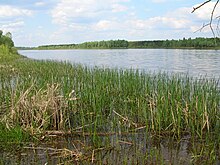Pripyat Marshes

The Pinsk Marshes , after the river Pripyat named, also poles Malaysian swamps (after the landscape Polesia ), Pinskische Marshes (after the city of Pinsk ) or Rokitnosümpfe (after the city Rokytne called) are a swamp in southern Belarus and in northwestern Ukraine .
With an area of around 90,000 km², they are the largest swamp area in Europe around the city of Pinsk or around the Prypiat (Belarus: Prypjaz ) (between Bug and Dnepr ) and its tributaries Horyn , Pina , Ubort , Stochid and Turija as well as the lower reaches of the Styr in the south Polesia . The main cities are Pinsk, Mazyr , Prypiat , Rokytne and Chernobyl (Chernobyl).
The swamping is caused by the lack of gradient in the watercourses and the fact that in spring the southern tributaries thaw much earlier than the northern ones. The extensive swamp areas and the numerous tributaries flowing slowly in swampy valleys make agricultural use difficult. Only the timber industry has prevailed.
history
At the beginning of the First World War , the area was fought over between the 4th Army of Austria-Hungary and the 3rd Army Corps of the Russian Army in 1915/16 before the 2nd Army of Austria-Hungary could arrive on site. As the war progressed, the swamps remained one of the most important geographical obstacles on the Eastern Front .
The region was of the Wehrmacht in the German-Soviet war as a Wehrmacht hole , designated as there were no major German forces in the region. At the beginning of this war, Konrad Meyer was in command of the "Pripjet Plan", which provided for the settlement of the area with German colonists. However, the plan was dropped in late 1941 by Hitler , who feared dust storms would form . In the winter of 1943/44, fighting also took place in this area. In particular during the “ fight against gangs ”, the 8th SS Cavalry Division “Florian Geyer” committed numerous war crimes, including the murder of over 14,000 Jews between August 1 and 12, 1941.
The region was also made famous by the Chernobyl nuclear disaster in 1986. However, it should not be confused with the ghost town of Pripyat, 350 km south-east .
Nature reserves
The swamps are a protected, transboundary wetland according to the Ramsar Convention . The nature reserves include:
- Shazk National Park in Ukraine
- Polish State Radio-Ecological Protected Area in Belarus
literature
- Thomas Gerlach : Ukraine. Between the Carpathian Mountains and the Black Sea. 10th, expanded and updated edition. Trescher, Berlin 2009, ISBN 978-3-89794-152-6 .
- Diana Siebert: Techniques of rule in the swamp and their ranges. Landscape interventions and social engineering in Polesia from 1914 to 1941 . Harrassowitz Verlag, Wiesbaden, 2019. ISBN 978-3-447-11229-1 .
Web links
Coordinates: 51 ° 49 ' N , 24 ° 57' E
